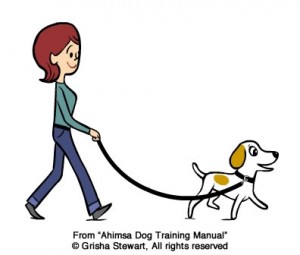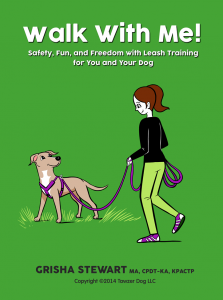
Related:
- Custom 15-foot long leashes for BAT are now available! We ship worldwide, with free shipping to the US.
- Walk With Me! Streaming feature-length video on walking skills for both ends of the leash (or DVD)
BAT should be a dance between the dog and the person. The human is the one who knows the plan for the dance, but the dog is the one who has the understanding of rhythm.
Your job is to read your dog and know when to just balance yourself and wait for your dog to gather info (most of the time) or when to cue your dog to move away (like if something has gone wrong and you’re too close). Always note signs of increasing excitement, like the dog focusing on the trigger or walking straight at it, so that you know when to help your dog slowly stop.
I find it helpful to use a 15 foot (5 meter) long leash for BAT. I found them hard to find, so we now have some custom-made for our clients. Click here for info.
I don’t recommend much longer than that, or it just gets awkward and tangled. In a pinch, I’ll do that by clipping two leashes together (clip of one attaches to handle of the other) but I prefer to have one solid leash. I use my right hand to gather the extra leash and my left hand to dole out or gather up the leash, but either hand is fine.

For a BAT set-up and on walks, there is a time when you stop the dog so you are not going too close to the trigger. Body language and slow, soft braking with the leash go a long way. After you stop the dog, you will then wait for the dog to decide what to do at the “Choice Point.” Whenever you are done braking, relax the leash to make it a little loose, like the smile in a smiley face. Putting a smile in the leash is important! (thanks to Claire Goyer, CBATI for the smile phrasing)
If you get too close and need to run/jog/walk away from something, do your best to keep the leash loose, even letting out some line if you have to, so that your dog can move without added tension.
These longer leashes may take some practice to use on walks, but they are pretty cool. Only do so if you feel that you have control over your dog’s safety and the safety of others. For example, never let your dog go around a corner without you!
More resources:
- Free handout on my Handouts page. You may use this with your clients. One handout has more specific details on Leash Skills.
- “Walk With Me” video includes the BAT leash skills and training for the dog as well (heel and loose leash walking). Part of the BAT 2.0 Video Series.
- Effort-Less Dog Walking webinar with innovative and ergonomic ideas to handle strong pulling dogs (and small ones).
- BAT 2.0 book
- Online BAT courses and webinars